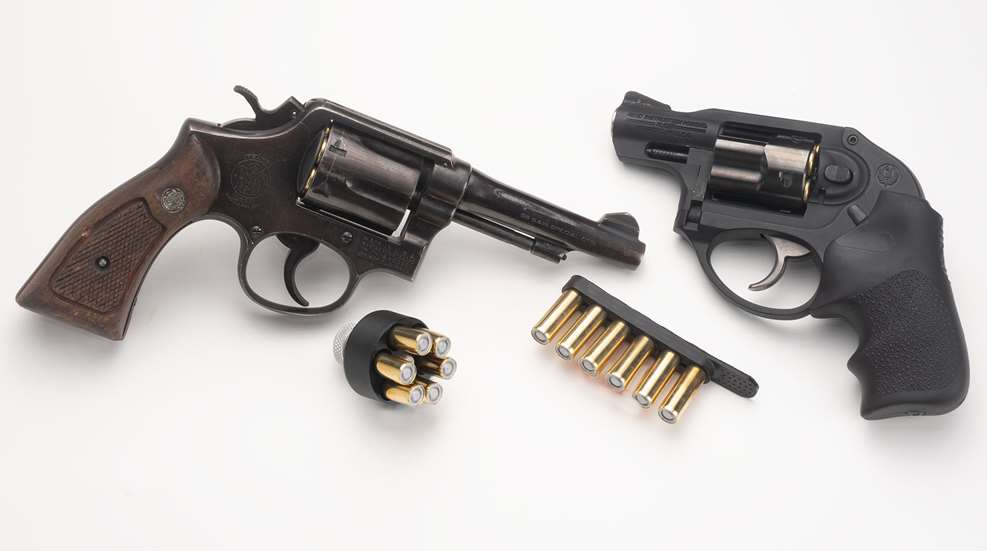
The reputation of New York City Police detective Jim Cirillo looms large over the firearms training community. Cirillo was involved in over a dozen gunfights, the majority of which happened during his time on the 70’s stakeout squad that was tasked with stopping violent armed robberies. The firearms he used while on duty were typical of the times: Smith & Wesson revolvers in .38 Spl and Ithaca 12-gauge pump-action shotguns. As you can imagine, it was quite easy to fire all six rounds in that Model 10 during a firefight with a band of hardened criminals, so Cirillo and other officers would be faced with a choice of reloading their wheelguns under withering fire or going to a backup gun carried elsewhere on there person. Cirillo maintained that going to a backup gun was faster than reloading a revolver, and thus the term “New York reload” was born. But, is going to another gun actually faster? Let’s find out.
We’re going to need a backup gun, and for that, I’ve chosen a Ruger LCR in .38 Spl. The size of this gun makes it ideal for use as a “holdout” gun that is typically used to perform a New York reload. I’ll also be carrying it in places where you’d expect to see a backup gun, like in a pocket or an ankle holster.
Testing The New York Reload
First, I’ll test how fast it is reload using a speedloader and then again using speed strips. Then, I’ll test the speed of drawing from a crossdraw holster, and then finally, I’ll see how fast it is to get a backup gun into action from a pocket holster and an ankle holster.
I’m going to need holsters to facilitate all of this, so I reached out to Galco Holsters and they provided me with one of their excellent pocket holsters, as well has an ankle holster, a crossdraw holster and a high-ride OWB holster with a thumb snap, a common style of holster for police officers working in the 1970’s.
I’ll perform each drill five times, and then compare the average times of each drill against each other to get some idea of what’s actually fastest. I should mention here that I am not an expert revolver shooter. If you’re expecting Miculek-level revolver reload speeds, I’m afraid you’ll be sorely disappointed. However, I also don’t practice drawing from an ankle holster or a crossdraw holster either, so I expect my lack of practice with all of these skills to even things out in the long run.

Now let’s go to the range, and see if a New York reload really is the fastest way to get back into the action.
Test #1: Reloading Via Speedloader
Average Time Required: 10.0 seconds
Test #2: Reloading Via Speed Strip
Average Time Required: 13.05 seconds
Test #3: Drawing A Backup Gun From A Pocket Holster
Average Time Required: 4.02 seconds
Test #4: Drawing A Backup Gun From A Crossdraw Holster
Average Time Required: 3.23 seconds
Test #5: Drawing a Backup Gun From An Ankle Holster
Average Time Required: 3.81 seconds
Conclusions
I should mention right away that I was wearing shorts the day of the test, and so the times for the ankle holster should be doubled at the very least to account for clearing your pant leg away from the holster and then accessing your backup gun. Even with that longer amount of time, however, it’s still faster to draw another gun from an ankle holster than trying to reload a wheelgun.
At first, the times for drawing a gun from a crossdraw surprised me a bit. Three or so seconds is a good time for inserting a fresh magazine into a semi-automatic pistol. Knowing that I can potentially draw a new gun in the same amount of time makes a backup gun on my support side hip a very viable alternative to carrying a spare magazine in the same location.
The results for pocket carry were about what I expected. I’m very familiar with pocket carry, and I understand that it can be fast (very fast) if you’re able to get your hand on your gun before things go pear-shaped, but if not, it can be a chore to get your gun into play.
Taken as a whole, though, the “New York Reload” is definitely a real thing, and a very viable alternative to reloading a revolver. In fact, in some instances, it may be just as good to go with your second gun, even if you run a modern semi-automatic pistol. If you’re unfortunate enough to have a gun break on you, or run into a more difficult malfunction like a double-feed or tip-up malfunction, then doing a New York Reload and going to a backup gun is probably your best option.





































